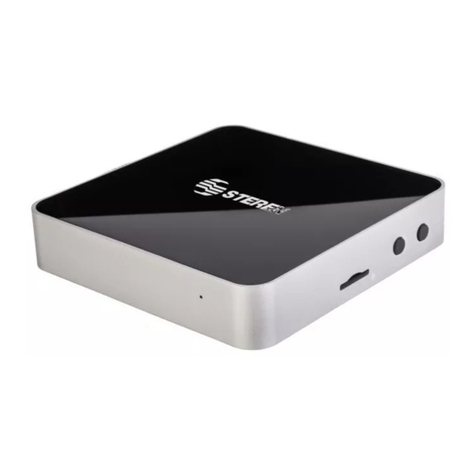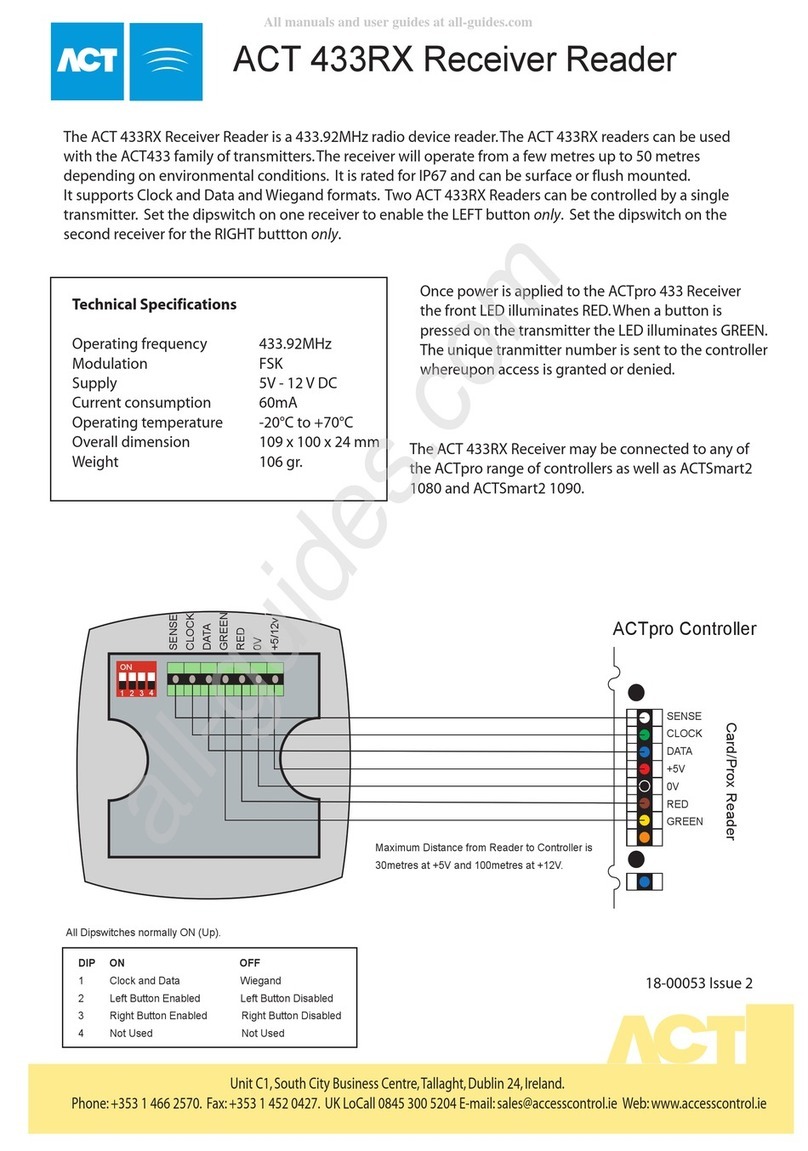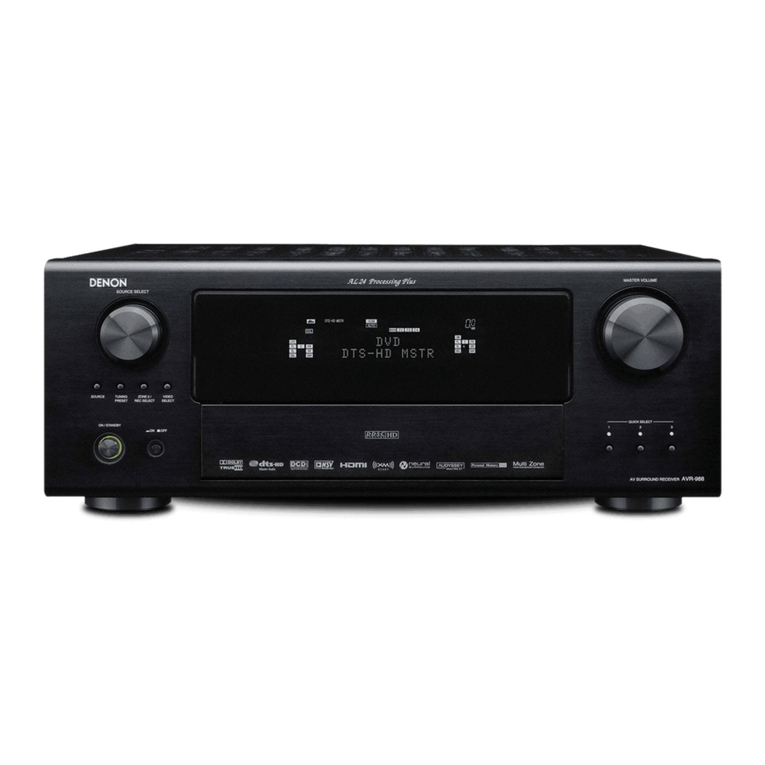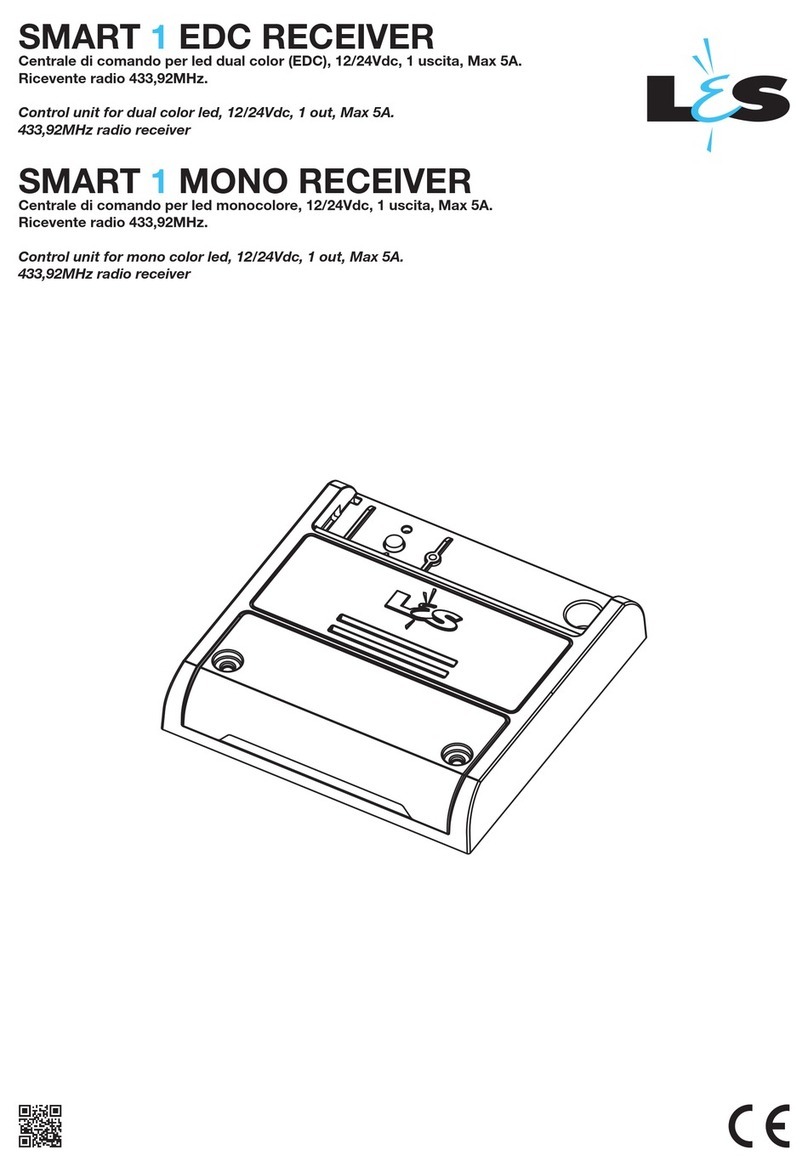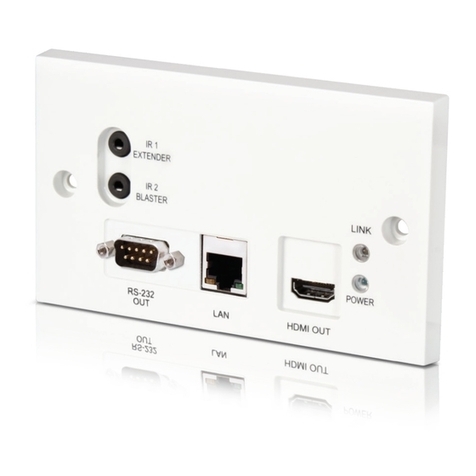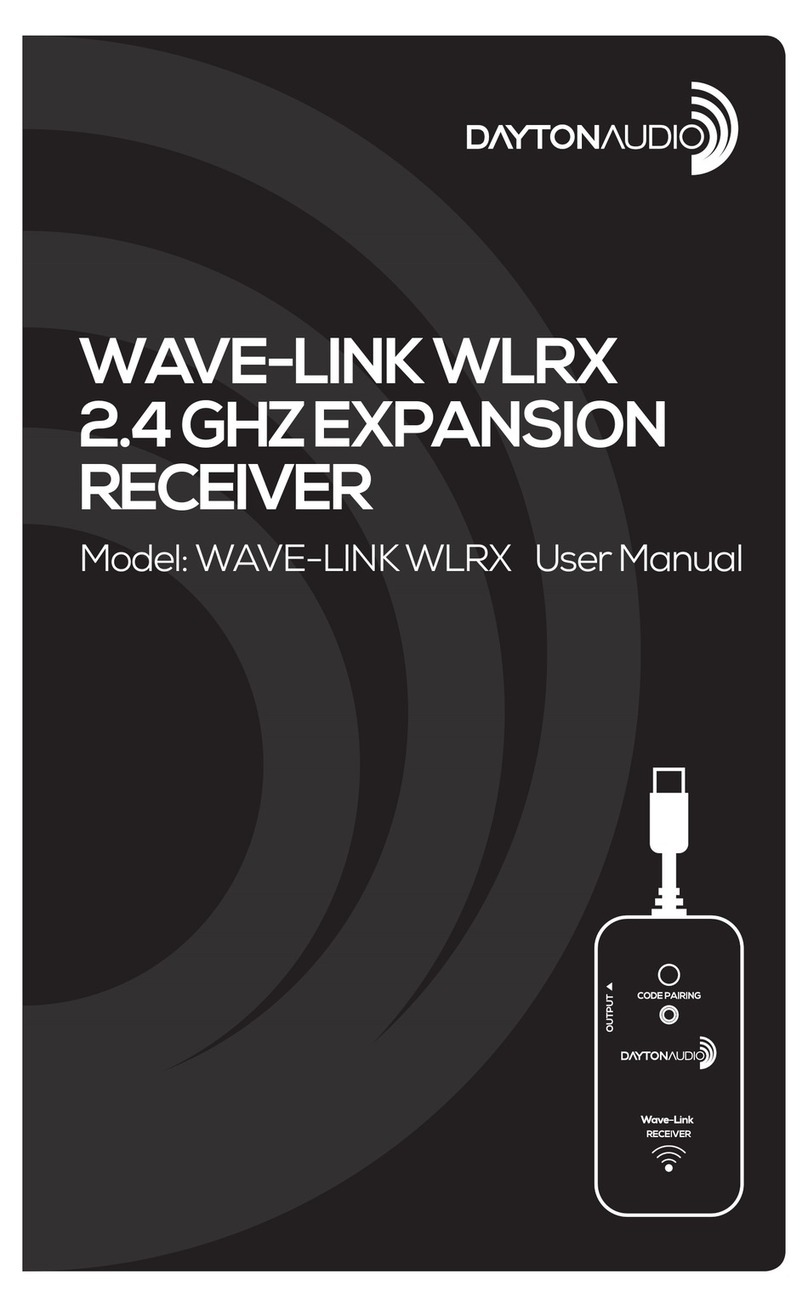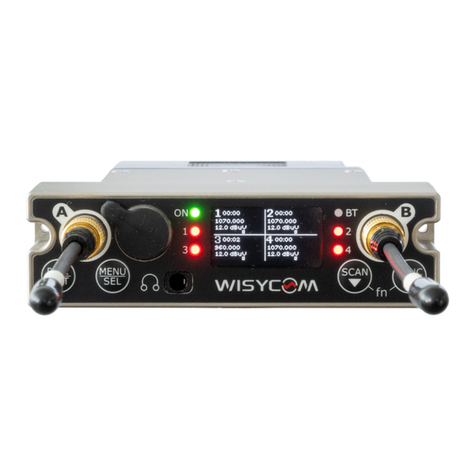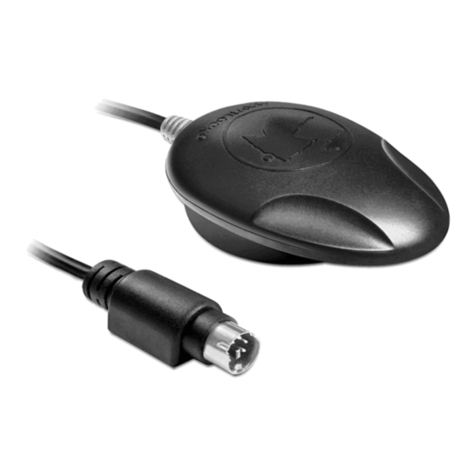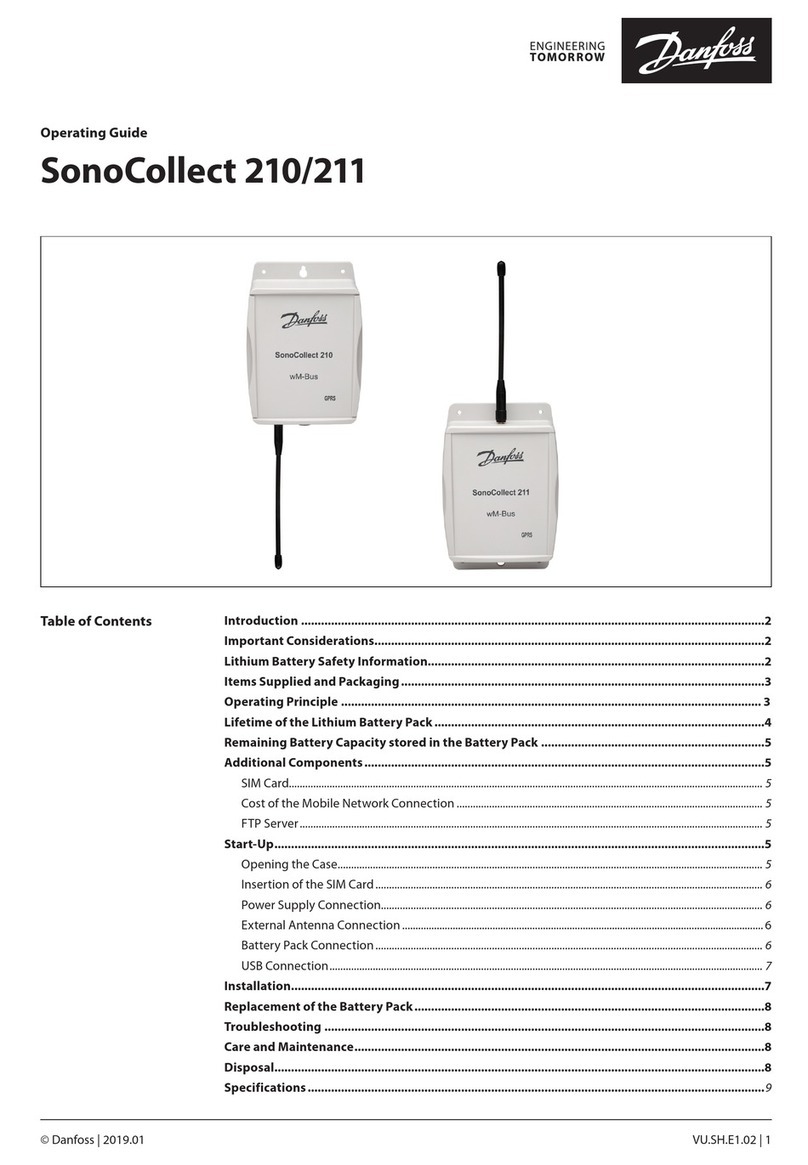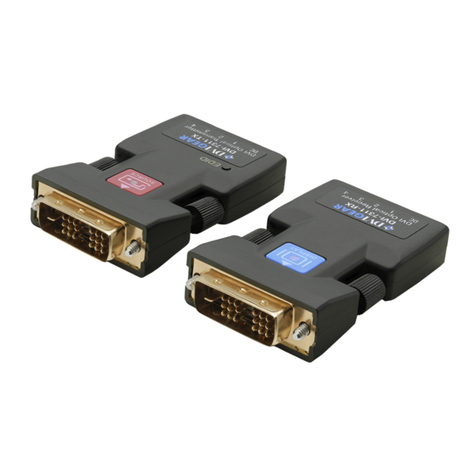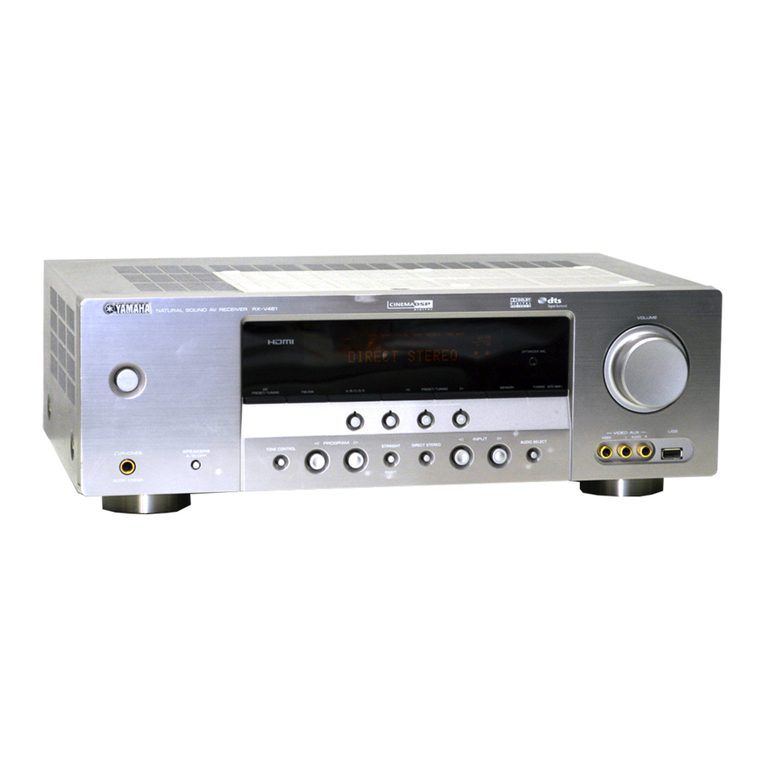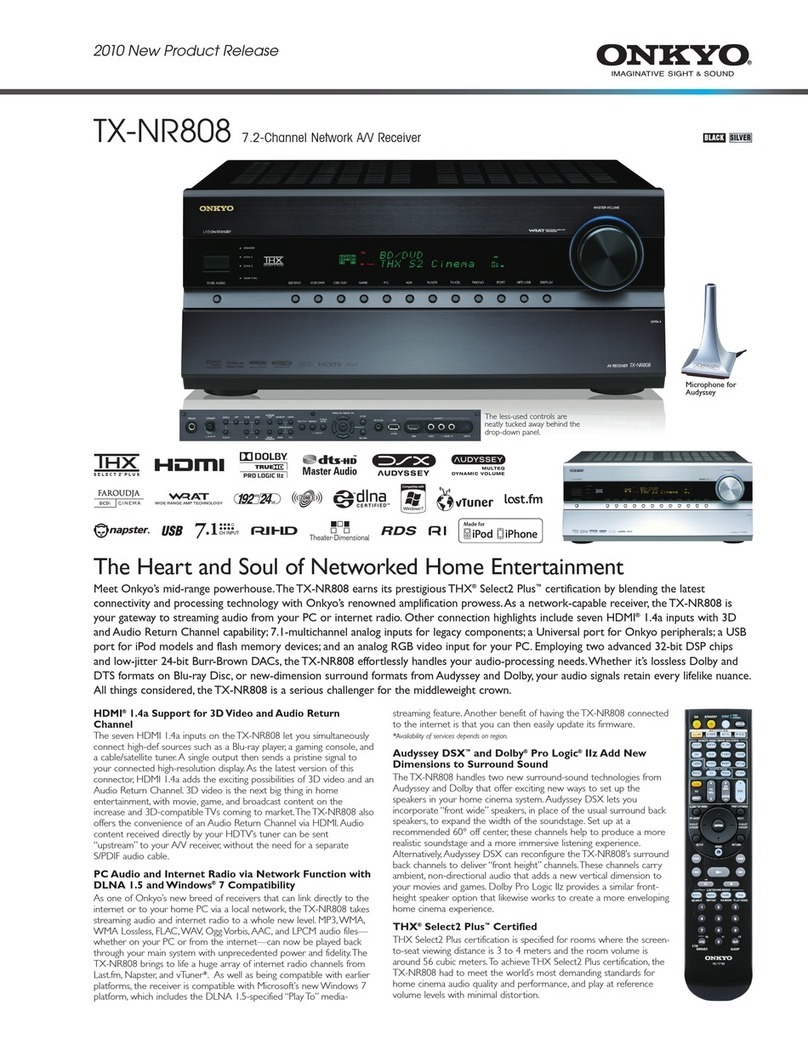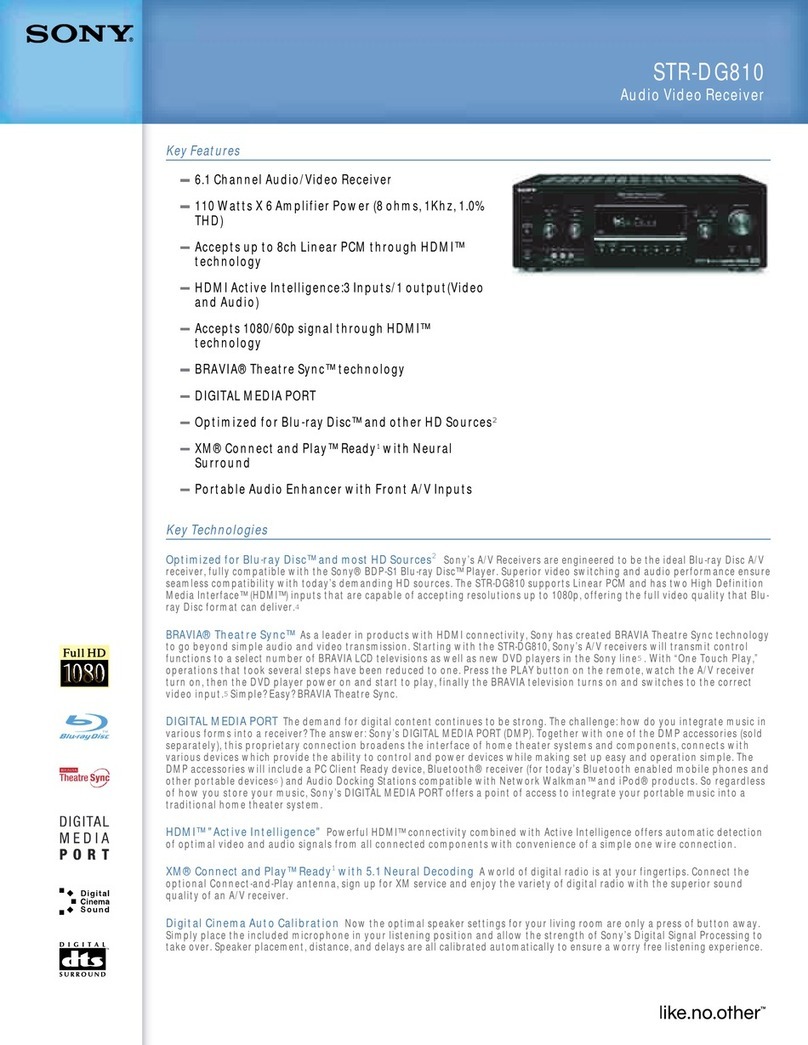Elmec U4HS User manual

Elmes Electronic 11.2015 All rights reserved.
FOUR CHANNEL WIRELESS CONTROL RECEIVER & SETS WITH DYNAMIC CODE U4H
Universal four relay outputs receiver (U4HR)* and sets (U4HS & U4HSL)* are designed for use in alarm systems and remote control applications. The sets consist of
U4H receiver and one four buttons hand held remote control transmitter. The devices use KEELOQ
®
dynamic coding technology and the receiver operates with all
Elmes Electronic made 434 MHz radio band transmitters and wireless detectors including specific RP501 transmitter made by Elmes Electronic.
Receiver operation
Activating transmitter stored in receiver memory sets on respective relay output and LED indication in the receiver. Depending on programmed operating mode, the
output may be set on temporarily for earlier programmed time period (monostable mode) or set on until next signal is received from transmitter in on/off mode
(bistable mode). These two basic output modes relate to U4H receiver operation with most transmitters. However, in operation with RP501 transmitter in its radio
relay mode (mode 3) or CTX3H and CTX4H wireless magnet detectors operating in open/close detection mode, the receiver relay output set on state lasts until set off
signal is received, regardless of the receiver output programmed operating mode.
Description of jumpers JP1...JP5
JP1 and JP2 setting define possible signal output S (OC type) operation modes, as shown in the cross table below:
Jumper setting
JP2 ON
JP2 OFF
JP1 ON
Two pulses shorting to ground are generated at output S on any relay set on,
one pulse –on any relay set off
Output S is permanently shorted to ground on any
transmitter low battery signal received (no indic.
pulses are generated on outputs set on/off )
JP1 OFF
As above, but shorting pulses are related to channel 1 output only
JP3 –shorting/pause timing of pulses at output S (jumper ON –0.25/0.25s, jumper OFF –0.5/0.5s).
JP4 –setting this jumper OFF allows simple alarm control panel function of U4H receiver –for detailed description see wireless control panel section below.
JP5 –setting this jumper OFF switches operating mode of U4H receiver and it’s all outputs to user controlled real time operation with programmable set off delay.
In this mode output of the receiver is set on for as long as its respective button is kept pressed in remote control transmitter. The setting off of the output is made with
transmitter button release, after a programmable short time delay needed to avoid possible interruptions in operation of the output due to interferences caused by e.g.
electric motors. Precise programming of this short delay time is facilitated by build in 8-fold longer programming time of that really needed. Example: to obtain 0.5s
set off delay after transmitter button release, the programmed delay time in pt 2 step 4 of programming procedures should be 4s.
IMPORTANT: Delay time programming facilitation is active only with JP5 set OFF and U4H memory of remote control transmitters is limited to 20 in this mode.
LED indication –lights green on all outputs off, lights red on any output on, blinks when transmitter low battery warning is on in any channel.
Low battery warning. This function is supported for all Elmes Electronic remotes and transmitters PTX50, GBX, CTX and RP. Blinking receiver’s LED indicates
detected low battery in one of the transmitters. Number of blinks in a series indicates channel number where low battery is detected. Additionally, output S is shorted
to ground if jumper JP2 is set off. Low battery warning sets off after battery is replaced and transmitter activated.
Anit-sabotage protection (TAMPER). Opening of the U4H receiver’s housing is detected as TAMPER circuit break-in.
Installation (as shown on fig.1)
U4H receiver is designed to operate in ambient temperature range from -20 to +55
°
C, protected from direct atmospheric
conditions. Place of installation should be dry and away from any electromagnetic power lines, radio transmitters, metal
screening and other devices that may cause interference and reduce operation range. Practical operating range test using
optional RFM4 monitor is recommended prior to firm installation. Receiver’s wire antenna should be let loose downwards
and must not be glued to any surface. Receiver’s relay outputs standby mode (NO-normally opened or NC-normally closed)
is selected by jumpers, individually for each output.
Specification
Design for use with 433,92MHz band transmitters and wireless detectors.
Four galvanic separated relay outputs rated 1A/30VDC or 0,5A/125VAC.
Outputs set on timing in monostable (pulse) mode 0.25s up to 4h.
Receiver’s power supply depending on version specified at the label: version 12VDC: 10-15VDC, version 24VDC/AC: 19-32VDC or 19-27VAC.
Current rating: 20mA at standby and 120mA max.
Signal output S rated 1A/60V max.
WARNING! Signal output S (open collector type) is shorted to receiver ground when activated and must not be directly
connected to (+) of power supply.
Manufacturer: Elmes Elektronik, 54-611 Wroclaw, Avicenny Str. 2, PL. Phone: 0048717845961, 0048717845962, Fax: 0048717845963
Manufacturer’s Limited Warranty: this product carries 24 months manufacturer’s warranty as from the date of purchase. The warranty is limited to the replacement
of faulty original parts or repair defects of improper manufacture. Damage, faulty use or improper handling by the user or installer as well as any changes in product’s
hardware or software caused by the user violets the warranty and all due repair costs will be charged. Elmes Electronic shall not bear liability for any personal or
material damage resulting from any of its products direct, indirect or partial failure to operate properly.
KEELOQ
®
is a registered trademark of Microchip Technology Inc., USA.
U4H RECEIVER IN WIRELESS CONTROL PANEL MODE
When JP4 is set OFF the U4H receiver operates in wireless control panel mode (see Fig.2 –for connections example) featuring the following specifications:
Eight wireless alarm zones for up to 112 Elmes Electronic wireless detectors and remote control transmitters.
Arming and disarming by Elmes Electronic remote control transmitter.
Alarm events memory (also on power cut off) with alarm zone indicated by LED.
Non-volatile memory of system status armed/disarmed on power supply restore after cut off.
Panic alarm function by hold pressed remote control transmitter button for more than 2s.
Number of alarms occurring in armed mode limited to five.
Four relay outputs NO/NC type (jumper selected) with the following functions:
-output D1 –armed/disarmed signalling,
-output D2 any application, example: set on/off by the use of 2nd button of transmitter,
-output D3 –optical and/or audible alarm signalling,
-output D4 24h alarm zone (detector’s TAMPER alarm or panic button function).
Siren/buzzer control output OC type (open collector - 1A/60V) active on:
-system arming (one pulse), disarming (two pulses),
-indication of occurred alarm event by 6 short pulses on disarming of the system,
Bicolour LED featuring system warnings and indication, as follows:
-system armed - lights red, disarmed –lights green,
-alarm event memory - flashes red when system is armed, and up to 2 minutes after disarming,
-transmitter’s low battery warning - flashes green when the system is disarmed where
number of flashes (1..8) indicates alarm event zone number, or detector’s low battery zone.
+
D1D2D3D4 S
Receiver's board
_
12V
+_
OUTPUTS
tamper
NC output
NO
NC
NO
NC
NO
NC
NO
NC
+
Buzzer
+
D1D2D3D4 S_
Power
Siren
Strobe
++- -
Wired siren
12VDC
+-
supply
Fig.1
Fig.2

EIGHT CHANNELS DYNAMIC CODE RECEIVER CH8HR (EN)
This microprocessor controlled eight channels receiver is designed to operate with large number of transmitters in wireless alarms and access
control systems using KEELOQ® dynamic signal coding offering highest level of security. The receiver features eight galvanic separated NO/NC relay outputs with
front panel LED channel indication and signal control output S. It operates with all Elmes Electronic made 433,92MHz band wireless detectors and transmitters
including RP501 and features warning signals of radio link failure, cabinet opening or tamper and low battery state in learned transmitters.
Each channel may have learned any number of transmitters with total number not exceeding 40. Learning next transmitter would delete first in memory. The need to
delete a lost transmitter requires deleting all in receiver’s memory and learning remaining transmitters again. The CH8H receiver offers range of applications including:
- wireless detector’s interface to any wired control panel monitoring alarm signals from Elmes Electronic wireless transmitters such as CTX, GBX, PTX and RP501
and UMB100H hand transmitter programmed to channel one arming and disarming the system;
- calling and wireless panic button with users having hand transmitters (e.g. AN200H or UMB100H) as personal panic button alarm triggers. In calling system, the
use of hand transmitter would set on a call lasting for earlier programmed time period. Two channel hand transmitters (e.g. DW200H or DWB100H) used as wireless
panic buttons may have one button used for quiet alarm function while the other used for a loud panic alarm.
OPERATION
Activating transmitter programmed to CH8HR receiver sets on respective channel relay output and illuminates the channel’s LED. Depending on programmed
operation mode (see programming procedures p.2) the receiver’s relay outputs are set on & off in one of two following modes:
1. Momentary (pulse) mode lasting from 0.5 second up to 4 hours.
2. Latching (on-off) mode setting relay output on and off by consecutive signals received from transmitter.
Output S generates two pulses on any channel relay set and one pulse on reset. Also, it signals low battery and radio link failure warnings according to settings made
with jumpers JP1, JP2 & JP3 (see table below). Multichannel transmitters and RP501 transmitter always set on/off adjacent relay outputs. Elmes Electronic PTX, GBX
and CTX wireless detectors signal alarms in two channels: motion detection in any of the eight channels and tamper alarm in channel eight - automatically assigned at
learning the detector to receiver procedure. The channel number eight signals also receiver’s power cut off, cabinet opening and wiring cut off.
Operating with RP501 transmitter in radio relay mode or with CTX3H and CTX4H detectors operating in open-close monitoring mode, the receiver’s outputs state
correspond to the transmitter’s inputs meaning that the outputs are set on for as long as the transmitter’s inputs are opened. In case of CTX4H, for as long as the
magnet stays away.
The receiver monitors battery state in Elmes Electronic transmitters type PTX50, GBX, CTX and RP. Detected low battery in one of the transmitters is signaled by
blinking of the front panel main LED and, if the JP2 is opened (see table), by output S shorted to receiver’s ground. The number of LED pulses in a series correspond
to channel number with low battery detected. The signaling sets off automatically after battery is replaced and transmission activated.
Identically, the CH8HR receiver signals failure of radio link in operation with transmitters PTX, GBX and CTX4H (CTX4H serial number > 610000). The transmitters
send identification signal every 10 hours. If any signal is not received by receiver within 24 hours time period (e.g. for reason of its failure) this will be warned by
blinking receiver’s main LED and, if JP2 is opened, output S shorted to ground. To activate this function, jumper JP3 should be set open.
INSTALLATION & OUTPUTS SETTING CH8HR wiring diagram:
Receiver CH8HR is designed for indoor operation only within temperature range of 0 to +40
°
C. Operating range
with wireless detectors and transmitters highly depends on place of installation. High humidity, electromagnetic
power lines, nearby radio transmitters or metal screening may cause interference and reduce operation range.
Receiver’s wire antenna should be let loose downwards and not glued to wall. Jumpers placed next to output relays
on the receiver’s pc board are used for selecting standby mode NC (normally closed) or NO (normally opened).
Table - operating modes of output S
JP2 shorted
JP2 opened
JP1 shorted
Two pulses on any output set on, one pulse
on output set off
Shorting to ground at low battery warning.
Radio link failure signaling if JP3 also opened
JP1 opened
Pulses on channel 1 set on/off only
PROGRAMMING PROCEDURES
Programming is made with housing’s front panel taken off and the use of PRG switch on the receiver’s board.
1. Learning transmitter(s) to receiver's memory (maximum 40).
a) Press receiver's PRG switch for less than 2 seconds. The receiver’s central LED switches to red and the first
channel set on LED illuminates,
b) Shortly pressing the PRG switch select the required channel for programming transmitter to,
c) Press the PRG switch until the receiver’s LED switches to green,
d) Depending on type of programmed transmitter proceed as follows:
- for hand transmitters –double press the transmitter’s switch. For multi channel transmitters press switch number respectively to number of channels to program,
example: double pressing the 3rd switch in four ch. transmitter CH4H will program first three channels. The fourth channel will not be active in this receiver.
- for the PTX50 detector –set the detector internal transmission channel selector to 1 and activate two transmissions by moving hand in front of the detector,
- for the CTX3H, CTX4H wireless contacts –activate double transmission by double quickly moving magnet in and out of the CTX housing,
- for the RP501 transmitter (operation with radio link testing is not allowed) - set the required mode of operation and activate transmission by opening any of
its four inputs respectively to number of channels required, example: activating input 2 will program input 1 and 2, while 3 and 4 will not be programmed.
e) Slowly blinking LED in the receiver will indicate end of the procedure.
2. Setting the outputs’ set on time in selected channel.
a) Press receiver's PRG switch for more than 2 and less than 8 seconds. LED switches to red and next to green. The first channel LED illuminates.
b) Pressing the PRG switch select (illuminating LED indicates selected ch.) required channel for programming its output momentary set on time:
c) Press the PRG switch for longer than 2s, till the receiver’s LED switches to red.
d) Shortly press PRG switch and the LED switches to green (counting of set on time is started). When desired set on time has lapsed (up to 4 hours) press the PRG
switch again. The LED lights red and after next 2s blinking receiver’s LED indicates end of the procedure.
NOTE! To program latching (on/off) output mode of selected channel press the PRG switch three times at subcl. 2d with less than 2s intervals.
3. Deleting all transmitters from the receiver's memory.
Press receiver's PRG switch for more than 8 seconds (the receiver’s LED switches to red and next to green), until the receiver LED starts blinking and then release
the switch. Memory of the receiver is cleared but the channels' programmed modes of operation remain unchanged. To learn new transmitter(s) to the receiver's
memory follow procedure 1 above.
4. Deleting a single hand transmitter from receiver’s memory.
It is possible to delete a single hand transmitter from receiver’s memory under condition that the transmitter is in our possession. This tricky procedure requires
performing steps 1abc in learning procedure 1 above, while in step d first transmission must be sent from the transmitter to be deleted and second transmission from
any other transmitter or, by pressing other button in multi button hand transmitters. Receiver LED blinking red will indicate programming error –in this case
meaning that the transmitter is deleted. The receiver does not respond to signals send from deleted transmitter any more.
+
128 S
Receiver's board
_
12V
+_
Relay's outputs
NO
NC
NO
NC
NO
NC
+
Buzzer
Note: programming errors are indicated by fast blinking LED. The receiver sets off programming mode automatically if activity is not detected within 30 seconds.
SPECIFICATION
-eight channels with NO/NC galvanic isolated relay outputs rating: 1A/24VDC or 0,5A/125VAC and LED indication;
-superhet 433,92MHz band receiver with front panel LED indication; output S for external siren and 40 transmitters memory;
-power supply 11 to 15VDC (nominal 12VDC) with 180mA max. current on all relay outputs set on.
Manufacturer’s limited warranty. Elmes Electronic products carry manufacturer’s one year limited warranty as from date of purchase. The warranty is limited to the
replacement of faulty original parts or repair defects of improper manufacture. Damage, faulty use or improper handling by the user or installer as well as any changes
in product’s hardware or software caused by the user or any other unauthorized person violets the warranty and all due repair costs will be charged. Elmes Electronic
shall not bear any liability for any personal or material damage resulting from its any product direct, indirect or partial failure to operate properly.
KEELOQ®is a registered trade mark of Microchip Technology Inc., USA.
ELMES ELECTRONIC, phone (+4871)7845961, fax 7845963, e-mail: elmes@elmes.pl www.elmes.pl
Elmes Electronic 07.2015. All rights reserved.
This manual suits for next models
1
Table of contents

